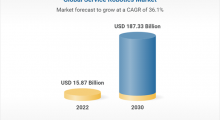The “Service Robotics Market, Volume, Size, Global Forecast 2023-2030, Industry Trends, Growth, Share, Outlook, Impact of Inflation, Opportunity Company Analysis” report has been added to ResearchAndMarkets.com.
The global service robotics market is set for substantial growth, with an anticipated value of US$ 187.33 billion by 2030, according to this report, reaching a CAGR of 36.15%. The market valuation in 2022 was $15.87 billion.
According to the report, as businesses and organizations grapple with rapidly changing consumer trends and various external factors such as labor shortages, trade issues, and supply chain disruptions, many are turning to cutting-edge technologies like service robots as a solution. Service robots find application across a wide range of industries, with their primary purpose being to alleviate human workers from routine tasks, allowing them to focus on more critical, customer-centric activities.
The professional service robots market is witnessing continuous growth, fueled by rapid technological advancements in robotics, including automation, artificial intelligence, engineering, and machine learning, the report states. The proliferation of robots has transformed the capabilities of humans, leading to increased task efficiency—a significant benefit. The International Federation of Robotics reports a threefold increase in the number of robots in recent decades. Advancing robotics trends are expected to drive the development of robots over the next two decades.
The adoption of robotics is expected to boost productivity and improve economic conditions in developing nations. Commercial service robots are poised to expand into a wide range of industrial sectors in these countries, where labor shortages have been a limiting factor. Automation and robotics are opening up numerous opportunities in industrial and residential sectors, bridging the skills gap and enhancing overall industry operations.
Service robots are poised to benefit from technological advancements such as edge artificial intelligence chips and the widespread rollout of 5G in telecom infrastructure. These developments are expected to provide substantial advantages, particularly to professional service robots, offering high performance while consuming less energy. Major market players are also focused on delivering advanced and comprehensive designs for various robotic solutions. Qualcomm, for instance, introduced the world's first 5G and artificial intelligence-based platform, designed for business-to-business and industrial service applications.
Article topics
Email Sign Up













